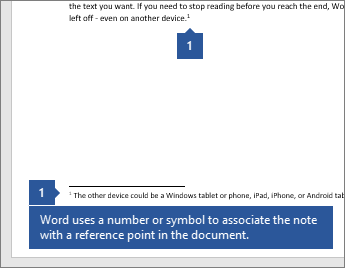
- CREATE A FOOTNOTE IN WORD 2016 HOW TO
- CREATE A FOOTNOTE IN WORD 2016 SERIES
- CREATE A FOOTNOTE IN WORD 2016 MAC
Always save a copy of your document before manipulating it.
CREATE A FOOTNOTE IN WORD 2016 MAC
Mac compatible versions of Word should have similar options. Please note, these hints work with versions of Microsoft Word currently in use – Word 2007, Word 2010 and Word 2013, all for PC.
CREATE A FOOTNOTE IN WORD 2016 HOW TO
How to swap between using footnotes and endnotes This article has explained how to change the number format in your footnotes or endnotes. You can change this as many times as you want. When we return to our document, the endnote numbering has changed from a roman numeral (i) to an arabic numeral (1). Once you have got the correct format in this box, click the Apply button to apply the changes: The Number format will now change to the one that you have chosen. Now click on the format that you want to use: Once you’ve clicked that arrow, you will be able to see all of the choices you have for your footnote or endnote numbering. Going down one section, you can see that at the moment, the Number format is set to i, ii, iii … To change this, click on the down arrow to the right of the box saying i, ii, iii … (if the Endnotes are set to 1, 2, 3 or a, b, c, this will display in this box): This tells Word that we’re using Endnotes and talking about the Endnote numbering. In this case, we’re using Endnotes (although these instructions cover both), so I’ve clicked the radio button (circle) next to Endnotes. But for our purposes, the important features are choosing whether you’re telling Word about Endnotes or Footnotes and telling Word what the number format should be. (these more obscure details will be the subject of another article). We can see lots of things we can do here, including changing the number footnotes start at, whether they restart every chapter, etc. Once you’ve clicked on the little arrow, you should see this menu: This is in the References tab, and there’s a whole area called Footnotes:Ĭlick the little arrow at the bottom right of the Footnotes area to access the Footnote and Endnote menu. Now, we want to change them to, for example, arabic numerals (1, 2, 3 …)įirst of all, go to the Footnotes menu. In this example, we’re starting off with some footnotes or endnotes that use roman numerals (i, ii, iii …): How to change the number format for footnotes/endnotes If you’re re-using an article which has been rejected by another journal, or repurposing a chapter of your PhD, you might find that the style for one journal is different from what you’ve done previously.Īlternatively, you may just decide you would prefer to use roman numerals, arabic numerals, symbols or whatever for your footnotes or endnotes, and want to change them. For example, academic journals will usually have some form of Guidelines for Authors which will lay out (sometimes) the font, heading styles, reference styles and footnote styles that you are expected to use. The main reason to change your footnote or endnote numbering style is because of the style guide of whatever you’re writing the document for. Why would I want to change my footnote or endnote numbering style?


while editing someone’s work, or when you change your mind, or when you’re working to a particular journal’s style and need to amend something you’ve already written) in Word 2007, Word 2010 and Word 2013.
/001-inserting-footnotes-in-word-document-3540270-437b98cb2b484a7f98d34e24cd0bbc80.jpg)
CREATE A FOOTNOTE IN WORD 2016 SERIES
As part of my series on footnotes and endnotes, here’s how to change your footnote and endnote numbering styles on the go (e.g.


 0 kommentar(er)
0 kommentar(er)
